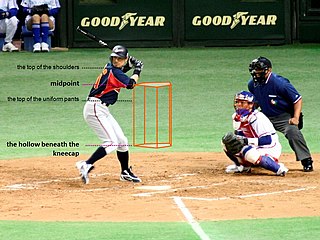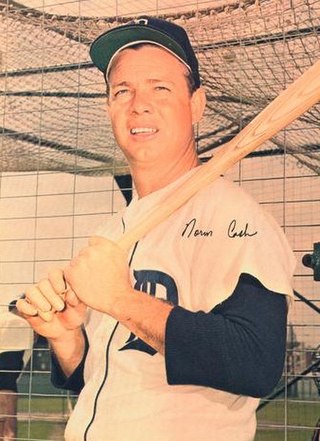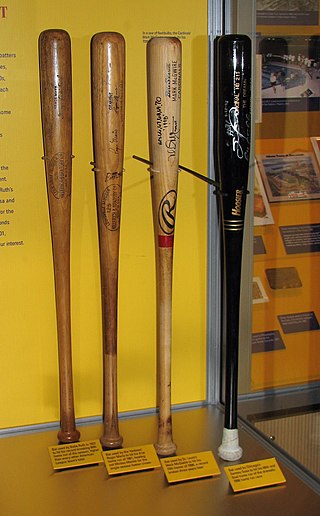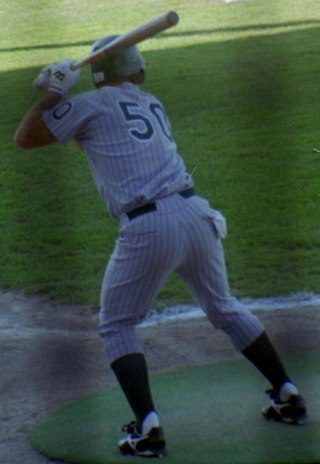Related Research Articles
Baseball statistics play an important role in evaluating the progress of a player or team.

In baseball, an at bat (AB) or time at bat is a batter's turn batting against a pitcher. An at bat is different from a plate appearance. A batter is credited with a plate appearance regardless of what happens during their turn at bat, but a batter is credited with an at bat only if that plate appearance does not have one of the results enumerated below. While at bats are used to calculate certain statistics, including batting average and slugging percentage, a player can qualify for the season-ending rankings in these categories only if they accumulate 502 plate appearances during the season.

Samuel Peralta Sosa is a Dominican-American former professional baseball right fielder. He played in Major League Baseball (MLB) for 19 seasons, primarily with the Chicago Cubs. After playing for the Texas Rangers and Chicago White Sox, Sosa joined the Cubs in 1992 and became regarded as one of the game's best hitters. Sosa hit his 400th home run in his 1,354th game and his 5,273rd at-bat, reaching this milestone quicker than any player in National League history. He is one of nine players in MLB history to hit 600 career home runs.

Peter Edward Rose Sr., also known by his nickname "Charlie Hustle", is an American former professional baseball player and manager. Rose played in Major League Baseball (MLB) from 1963 to 1986, most prominently as a member of the Cincinnati Reds lineup known as the Big Red Machine for their dominance of the National League in the 1970s. He also played for the Philadelphia Phillies and the Montreal Expos. During and after his playing career, he served as the manager of the Reds from 1984 to 1989.

In baseball, the strike zone is the volume of space through which a pitch must pass in order to be called a strike even if the batter does not swing. The strike zone is defined as the volume of space above home plate and between the batter's knees and the midpoint of their torso. Whether a pitch passes through the zone is decided by an umpire, who is generally positioned behind the catcher.

Norman Dalton Cash was an American Major League Baseball first baseman who spent almost his entire career with the Detroit Tigers. A power hitter, his 377 career home runs were the fourth most by an American League left-handed hitter when he retired, behind Babe Ruth, Ted Williams and Lou Gehrig; his 373 home runs with the Tigers rank second in franchise history behind teammate Al Kaline (399). He also led the AL in assists three times and fielding percentage twice; he ranked among the all-time leaders in assists and double plays upon his retirement, and was fifth in AL history in games at first base (1,943). He was known to fans and teammates during his playing days as "Stormin' Norman."

A baseball bat is a smooth wooden or metal club used in the sport of baseball to hit the ball after it is thrown by the pitcher. By regulation it may be no more than 2.75 inches (7.0 cm) in diameter at the thickest part and no more than 42 inches (1.067 m) in length. Although historically bats approaching 3 pounds (1.4 kg) were swung, today bats of 33 ounces (0.94 kg) are common, topping out at 34 to 36 ounces.

Throughout the history of baseball, the rules have frequently changed as the game has continued to evolve. The rules of baseball can vary slightly from league to league, with there being dozens of leagues worldwide. A few common rules most professional leagues have in common is that four balls is a base on balls, three strikes is a strikeout, and three outs end a half-inning. One example of differing rules in professional leagues is the use of a pitch clock, which in Major League Baseball (MLB) is in place to speed up the pace of the game by forcing pitchers to pitch in a 15–20 second window, while in Nippon Professional Baseball (NPB) no such rule exists.

A baseball is a ball used in the sport of the same name. The ball consists of a rubber or cork center wrapped in yarn and covered with white natural horsehide or cowhide, or a synthetic composite leather. A regulation baseball is 9 to 9.25 inches in circumference i.e. 2.86 to 2.94 inches in diameter, with a weight of 5 to 5.25 ounces.

In baseball, batting is the act of facing the opposing pitcher and trying to produce offense for one's team. A batter or hitter is a person whose turn it is to face the pitcher. The three main goals of batters are to become a baserunner, to drive runners home or to advance runners along the bases for others to drive home, but the techniques and strategies they use to do so vary. Hitting uses a motion that is virtually unique to baseball and its fellow bat-and-ball sports, one that is rarely used in other sports. Hitting is unique because it involves rotating in the horizontal plane of movement, unlike most sports movements which occur in the vertical plane.

Michael John Remlinger is an American former professional baseball relief pitcher. Remlinger has played in Major League Baseball (MLB) with the San Francisco Giants (1991), New York Mets (1994–95), Cincinnati Reds (1995–98), Atlanta Braves, Chicago Cubs (2003–2005), and the Boston Red Sox (2005). He had an All-Star appearance and his greatest success with the Braves. He bats and throws left-handed.

Amos Joseph Otis is an American former professional baseball player and coach. He played in Major League Baseball as a center fielder from 1967 to 1984, most prominently as an integral member of the Kansas City Royals team that won the franchise's first American League Western Division championship in 1976, and their first American League pennant in 1980. Although the Royals lost the 1980 World Series in six games to the Philadelphia Phillies, Otis produced a .478 batting average with three home runs in what would be his only World Series appearance.

Peter Edward "PJ" Rose Jr. is an American former professional baseball player and manager. The son of Major League Baseball's all-time hits leader Pete Rose Sr., Rose Jr. played in the minor leagues for most of his career except for a brief stint in 1997 for the Cincinnati Reds. Rose has since worked as a manager of multiple teams in both affiliated and independent minor league baseball.
The 1994 Chicago White Sox season was the White Sox's 94th season in the major leagues, and their 95th season overall. They led the American League Central, 1 game ahead of the 2nd place Cleveland Indians with a record of 67-46, when the season was cut short by the 1994–95 Major League Baseball strike.
The 1974 Detroit Tigers compiled a record of 72–90. They finished in last place in the American League East, 19 games behind the Baltimore Orioles. They were outscored by their opponents 768 to 620.
The 1994 Cleveland Indians season was the 94th season for the franchise. For the first time since 1986, the Indians finished the season with a winning record. However, the 1994 season ended prematurely due to the 1994–95 Major League Baseball strike that ended the season on August 12. It was the first season for the Indians playing at Jacobs Field after playing at Cleveland Stadium since 1946.

In baseball, batting average (BA) is determined by dividing a player's hits by their total at-bats. It is usually rounded to three decimal places and read without the decimal: A player with a batting average of .300 is "batting three-hundred". If necessary to break ties, batting averages could be taken beyond the .001 measurement. In this context, .001 is considered a "point", such that a .235 batter is 5 points higher than a .230 batter.
Composite baseball bats, opposed to aluminum or wood baseball bats, incorporate a reinforced carbon fiber polymer, or composite, into the bat's construction. This composite material can make up all or part of the bat. Bats made entirely of this polymer are referred to as composite bats. Bats which only incorporate a portion of polymer are referred to as composite hybr Composite bats can also be constructed to improve their trampoline effect over time. That advantage, namely the improved trampoline effect over a break in period, put the use of composite bats under further NCAA scrutiny during the 2009 NCAA Division I baseball tournament. Composite bats, tested after they were already broke in, showed performance standards well beyond the accepted ball exit speed ratio (BESR) Test.

Baseball personnel have cheated by deliberately violating or circumventing the game's rules to gain an unfair advantage against an opponent. Examples of cheating include doctoring the ball, doctoring bats, electronic sign stealing, and the use of performance-enhancing substances. Other actions, such as fielders attempting to mislead baserunners about the location of the ball, are considered gamesmanship and are not in violation of the rules.
References
- ↑ Russell, Daniel (2011). "What about corked bats?". Physics and Acoustics of Baseball & Softball Bats. Penn State University. Retrieved August 1, 2019.
A bat which has less mass, and especially which has a lower moment of inertia, may be swung faster.
- 1 2 Solomon, Christopher (June 23, 2011). "The physics of cheating in baseball". smithsonian.com. Smithsonian Institution. Retrieved August 1, 2019.
- 1 2 Nathan, Alan M.; Smith, Lloyd V.; Faber, Warren L.; Russell, Daniel A. (2011). "Corked bats, juiced balls, and humidors: The physics of cheating in baseball". American Journal of Physics. 79 (6): 575–580. arXiv: 1009.2549 . Bibcode:2011AmJPh..79..575N. doi:10.1119/1.3554642. S2CID 18919590.
- 1 2 Major League Baseball. Official Baseball Rules, 2019. Rule 6.03 (a)(5) § Batter Illegal Action.
- 1 2 Emerging Technology from the arXiv (September 16, 2010). "The misleading myth of the corked bat". MIT Technology Review. MIT. Retrieved August 1, 2019.
- ↑ "Corked bat-related penalty reduced by one game", ESPN.com news services, June 11, 2003 (accessed March 6, 2009)
- 1 2 3 "Sosa gets eight games, appeals Archived 2004-10-18 at the Wayback Machine ", MLB.com (accessed June 28, 2006)
- ↑ "Doctored bat infractions". ESPN. ESPN. Retrieved March 19, 2022.
- ↑ Snyder, Matt. "No deflating balls, but MLB has had several equipment controversies". CBS sports. CBS sport. Retrieved March 19, 2022.
- ↑ Sabin, Benjamin (March 15, 2021). "The Corked Bat: To Cork Or Not To Cork". Last Word On Baseball. Retrieved June 14, 2023.
- ↑ "Otis Confesses Use of Corked Bats to Help Hit .277 as Major Leaguer". Los Angeles Times. April 28, 1992. Retrieved June 14, 2023.
- 1 2 "2154640".[ permanent dead link ]
- ↑ Meltzer, Peter E. (June 10, 2013). So You Think You Know Baseball?: A Fan's Guide to the Official Rules. W. W. Norton & Company. p. 51. ISBN 978-0-393-34667-1.
- ↑ Petchesky, Barry (June 8, 2010). "This Is Pete Rose's Corked Bat". Deadspin . Gawker Media. Archived from the original on March 31, 2021. Retrieved November 6, 2021.
- ↑ Littmann, Chris (June 8, 2010). "Corked Bats Reportedly Belonging to Pete Rose Come to Light". SBNation . Retrieved June 16, 2016.
- ↑ "Pete Rose interview". The Cincinnati Enquirer . January 13, 2004. Retrieved June 16, 2016.[ permanent dead link ]